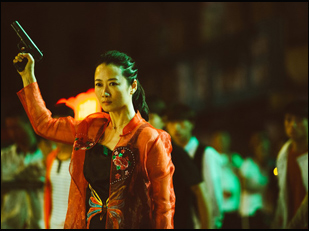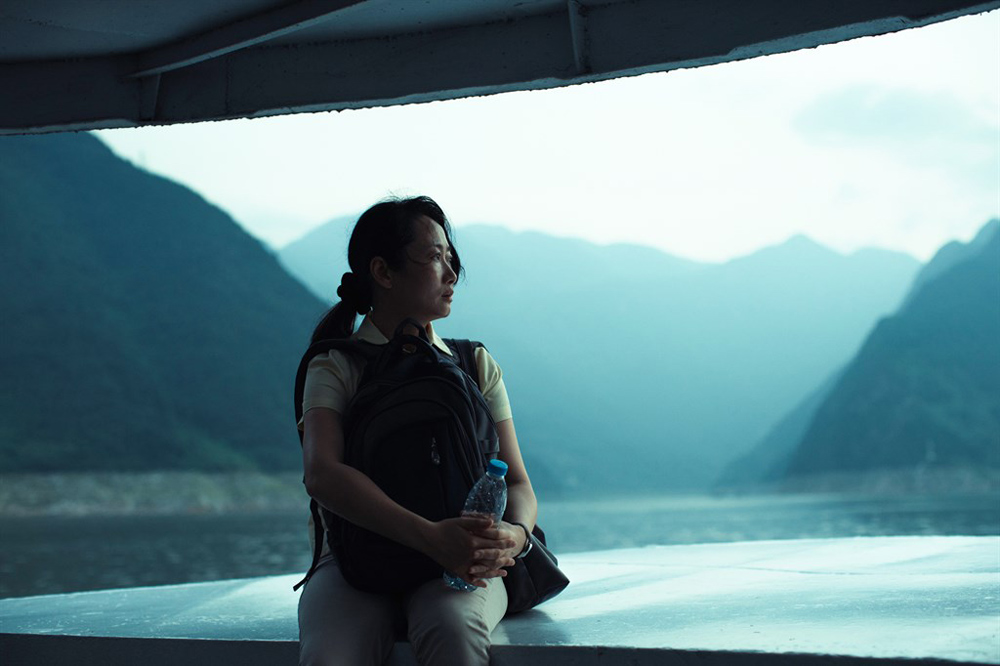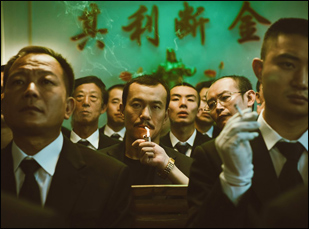There’s a small but important gesture shown throughout “Ash is the Purest White,” a sign of writer/director Jia Zhangke’s subtle expositional mastery when he always clocks who’s around to light the cigarette of Bin (Liao Fan), a soldier in the Jiang Hu underworld who rises to the point of seeing men stumble over themselves to thrust a lit match in front of his face, only to have his fall acknowledged by the fact no one will offer him their lighter. Such mini-narratives can be found everywhere in “Ash,” where the tiny stories add up to a much bigger one about the changing face of China, not unlike the way each of Jia’s films have added up to an unparalleled view of a nation that has undergone radical changes since making his first feature a little over two decades ago.
While it may feel like a coincidence that the director began his career around the turn of the century when China itself was taking a sharp turn towards modernization, it isn’t one that “Ash” covers roughly the same time that he’s been a working filmmaker, watching as Qiao (Jia’s longtime leading lady Zhao Tao) get pulled into the world of crime as Bin’s lover, keeping her head above water in a mining village in Shanxi where her father is among the many who have been laid off as a corporation moves operations to a potentially more prosperous region. Progress may pay immediate dividends for Bin, who initially reaps the rewards of a depressed community that seeks out income no matter where it comes from, particularly with a hungry new generation without many other opportunities to pursue, but soon sees a growth in competitors as the unemployed turn into the self-employed, with Qiao left holding the bag. Separated from Bin, she travels to Fengjie near the Three Gorges Dam in and returns to Datong covering the same physical terrain as Jia did in previous films “Still Life” and “Unknown Pleasures,” while breaking new ground narratively as Qiao struggles with a feeling of not being left behind, having to get crafty to adjust to a new reality.
Zhao’s ferocious turn as Qiao, which involves mixing it up with a few of Bin’s criminal foes, is worth the price of admission alone, but “Ash is the Purest White” may be Jia’s great achievement to date, richly rewarding longtime fans of the filmmaker with reflection on the places he’s captured in the past from the present while being his most accessible to newcomers in having fun with the gangster genre. Subtle touches, such as gently shifting the use of camera equipment from low-end DV cameras to high-end RED HD in collaboration with “Into the Wild” cinematographer Eric Gautier, articulate the ineffable effects of the passage of time and whether or not one was familiar before with Jia’s work, the cumulative power of his experience both behind the camera and what he’s witnessed as a citizen becomes overwhelmingly moving. While the filmmaker was in Los Angeles before the film’s U.S. bow following a premiere at Cannes last year, he spoke about the origins of the project and its nods to his other work, as well as how he collaborates with his wife Zhao and why he credits her with making the action scenes so extraordinary.
That’s going to be a long story, but I’m happy to tell it. [laughs] I have always wanted to make a movie that takes place in the Jiang Hu underworld because I was born in 1970, so I came of age with that decade and it was really soon after the Cultural Revolution and then obviously after the 1970s, there was a series of reforms when China went through its most dramatic, most rapid social transformation. It was really during that era that this underworld as we know it now emerged from contemporary Chinese society. Even as a kid, I was able to observe this in my hometown because the area that I came from is a mining region, so a lot of people due to financial and economic pressure and other reasons [would] get themselves involved in activities that are on the margins of society. I was also interested in talking about the values of the Jiang Hu world because the two most important values they have are love and loyalty, and in Chinese [culture], whether it’s literature or movies, there’s a lot of stories that deal with the Jiang Hu underworld, but these stories traditionally take place in the past. They’re about ancient China.
There was a particular figure that gave me the idea for the backdrop of the story because when I was a kid, there was this big brother-type person that we all looked up to [in town]. He was very handsome and very charming, charismatic and impressive. But years later when I was in college, I came back to my hometown and when I saw him again, he was basically a middle-aged man, crouching on the side of the street and eating noodles. He’s really not part of that [Jiang Hu] world anymore, but that particular image really gave me a sense of the way the passage of time impacts and shapes human beings, the way people go into decline and also how this particular passage of time also reflects the social transformation that happens on a constant basis, especially in contemporary China. So the principles of Jiang Hu really reflected what’s going on in contemporary society in a lot of ways, and it was a vantage point from which I could examine what goes on in the mainstream society.
I understand you were thinking of both “Unknown Pleasures” and “Still Life” as you were writing this – how did that shape this?
Actually when I wrote the first draft of the script for this film, I didn’t really think it was going to have anything to do with “Still Life” and “Unknown Pleasures,” but after I wrote the script, I was looking at it and I started to think this female protagonist was the same character from “Still Life” and “Unknown Pleasures.” In “Unknown Pleasures,” she implied Zhao Tao’s character is basically part of the underworld, but there really isn’t a lot of description or a lot of details about what her life is like in terms of her relationship with her boyfriend, and we didn’t really do anything to do with that. And it was the same with “Still Life.” Her character in that movie is getting a divorce from her husband, but there’s no description as to why that divorce is happening and what her backstory is. So then I had this inspiration that perhaps these are really the same character [whose story] I’m telling. Once I had that idea, I decided to name the character in “Ash is the Purest White” after the characters in those movies, so I named her Qiao, and even in terms of her design, the way her appearance comes off and her looks – they all end up reflecting how the characters look in those movies. I was very excited when this happened.

I usually hand her a script that’s already fairly finished because in the process of writing the script, I generally go through a lot of back-and-forth changes and revisions, so I worry if I hand her the script too early, it might create confusion, so it’s not as though the script is locked already [by the time she sees it], but I generally prefer the script is already at a stage where it’s already fairly set and there’s a pretty solid idea about what’s going on and that’s when I would involve her and get her feedback. She really gave me a lot of ideas and a lot of inspiration in terms of how she handles the character, particularly when it comes to certain feminine qualities and also very delicate details about the character that I didn’t previously have.
But actually after I finished up writing the script, I hesitated and paused for a while. I was trying to figure out what to do because this is a character [where there’s] quite a few years from her twenties to her forties, so initially I wasn’t sure whether or not to cast the same actor for this part or whether or not I should cast two, [with] one playing the younger version and one playing the older version. I feel like the same way with documentary filmmaking, when you observe a person’s transformation, there’s a certain emotion and infectious energy when you see a person age and a person gets shaped by the passage of time. But after I discussed it with Zhao, it was really her idea that it would be a challenge for her to play this character and interestingly enough, the main problem for was not to portray the changing of time or the process of aging. The main issue at the time was not knowing what the Jiang Hu world was like.
As much as you see the character evolve, you see the places around her as a reflection of how much has changed. Were those in mind from the start as much as the character?
Yeah, because in terms of design of the location, it was very much we started out in Datong and we’d go through the Three Gorges area and then ending up in the Xinjiang region, so it’s basically this really long and arduous inner journey that she goes through and that was driven by two desires – the first was to go back to the past and reveal what’s happened. The beginning of the film is set in 2001 because that’s really the beginning of a very important, very transformative period in China, the year when China was approved to have Beijing be the host city of the Olympics, when China joined the WTO, and also when we see this really rapid rise in terms of economic development and the internet became popular and pervasive. The second goal was to go back to the locations where I had filmed before, especially the Three Gorges area because for me that really captures how much China’s changed because this is a city that has thousands of years of history, but overnight the place has changed and millions of people had to migrate as a result of the building the dam. When I made “Still Life,” even at the time, I felt I should do more with this place. I felt I hadn’t done enough yet.
Was it interesting to revisit the technology that you used to capture these places? Because very subtly you can notice that you change formats in this film quite a bit as a reflection of the place.
Yeah, very much so. I used many different kinds of equipment to shoot this movie because in the year 2001, that’s when I first started using DV camera to capture what essentially ended up being documentary footage and later on as I was reflecting on the cameras I was using over the years – I’ve used DV cameras, I’ve used film stock, I’ve used 5D, a wide variety of things, just very eclectic, so that organically became a way to reflect the passage of time. The quality of the image and of the camera basically became an expression of what happened for me. Even in terms of the filmic language, it changes because the film more or less has the style and qualities of what we would refer to as genre films, but then slowly we move from genre films to a story that really focuses on the interior life of the men and women, so we went from using DV to using film stock to [HD] to capture this story because for me once it moves into this story about the inner struggle of the men and women we see onscreen, there’s a more observational, introspective kind of filmmaking that’s reflected in the actual quality and texture of the image.

“Ash is the Purest White” opens on March 15th in Los Angeles at the Arclight Hollywood and the Monica Film Center and New York at the Quad Cinema and the Film Society of Lincoln Center’s Walter Reade Theater. A full schedule of cities and dates can be found here.





